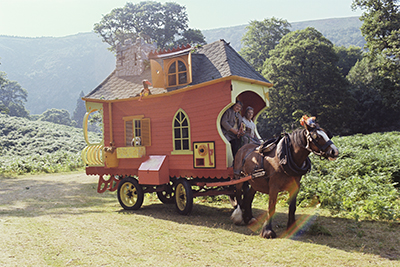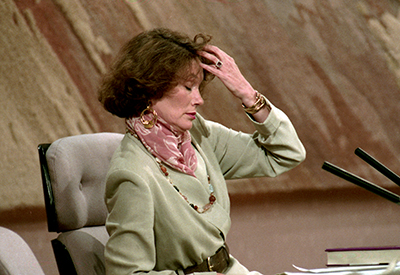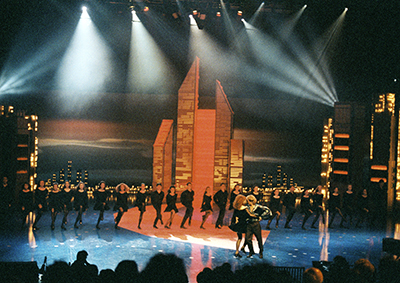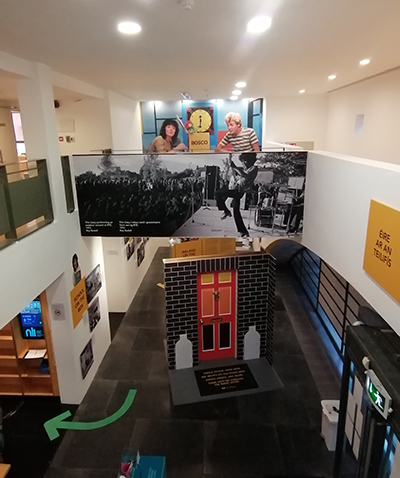IRELAND ON THE BOX
Published in Issue 2 (March/April 2022), Reviews, Volume 30National Photographic Archive, Meeting House Square, Temple Bar
https://www.nli.ie/en/national-photographic-archive.aspx
By Tony Canavan
Ireland on the Box, celebrating six decades of television in Ireland, is a collaboration between RTÉ and the National Library of Ireland. It is a historical exhibition insofar as it recounts the history of a national institution and reflects many aspects of Irish society since 1962, such as entertainment, drama, sport, music, education, and news and current affairs. It is historical, too, in the sense that television has not only reflected Irish society but also shaped it. The Late Late Show is well known for bringing many social topics into the open, but in general the presentation of culture and news coverage on RTÉ has helped form modern Ireland. The exhibition is also, however, an exercise in nostalgia. People of a certain age will remember many of the early programmes depicted here, with which they will have their own personal associations. I grew up in Belfast, which did not have access to RTÉ television until the 1980s (through the use of exceptionally tall aerials that were prominent across the city, even in loyalist areas), but we were familiar with Irish television from watching RTÉ when on holiday in the Republic. We were as enchanted as any Southern children with Wanderly Wagon, Fortycoats and Bosco, so this exhibition was a nostalgic one for me, too.

Above: Wanderly Wagon, which ran from 1967 to 1982—the exhibition is also an exercise in nostalgia. (RTÉ Archives)
Owing to Covid restrictions, the visitor must follow a set route through the exhibition. This doesn’t really affect the experience, as it is divided thematically so that you can see the development of Irish soaps, drama or sports coverage in their own sections. There is also a large screen showing a potted history of television on RTÉ, which helps to fix a time-line for the visitor. There is little in the way of objects on display or any interactive gizmos, but the photographs speak for themselves and will evoke their own associations and memories for most visitors.

Above: Annie Murphy talks about her affair with Bishop Eamon Casey on the Late Late Show on 2 April 1993. (RTÉ Archives)
It is remarkable that from the very beginning photographers were there to record the birth and development of Irish television. The exhibition does not just consist of screenshots of TV shows but also of photographs taken behind the scenes of the sets and the people involved. This gives a sense not only of history but also of intimacy. I was struck by the wide range of programming on RTÉ. We tend to take it for granted until an exhibition like this lays it out before us, but RTÉ has always been involved with every aspect of Irish society. The different sections of the exhibition illustrate this, from ‘Roll it there, Róisín’ and ‘A nation holds its breath’ to ‘Well, Holy God’ and ‘Coola Boola’. From an early stage RTÉ was involved in education, and it was not long before a TV set was a common educational tool in many classrooms. Outside of the classroom, too, RTÉ catered for the child and the teenager, not just with the aforementioned Wanderly Wagon but also with the likes of programmes such as Anything Goes and Zig & Zag.

Above: Riverdance, as originally performed at the 1994 Eurovision Song Contest in Dublin. (RTÉ Archives)
Great sporting moments are recorded here too, and Ireland’s triumphs in the Eurovision Song Contest are duly acknowledged, with photographs of Dana, Johnny Logan and other Eurovision heroes. How Irish society itself has changed is reflected in the developments of soaps from the rural idyll of Glenroe to the gritty streets of Fair City. Drama, too, has developed, with early ones being quite theatrical in contrast to the realism depicted in a series like Love/Hate. It is hard to do justice to every section of this exhibition and it would be easy to lose yourself in it for an hour or two, particularly if you are old enough to remember the 1960s, as were many of the visitors on the day I was there.
This exhibition is a celebration of television on RTÉ, and an unabashed one at that. Of course, there was television in Ireland before 1962, as most Irish people found ways to watch British channels and had been doing so for years. The exhibition does not acknowledge that fact or that it was suspicion of British TV influencing Irish cultural values that prompted the government of the day to support an indigenous national television station. On the subject of omissions, a large part of the exhibition is devoted to the Late Late Show, celebrating its pioneering programmes, key moments in its history and the success of the Christmas toy show. However, while Gay Byrne and Ryan Tubridy are represented, Pat Kenny, who anchored the show for ten years, is not mentioned at all. Has he been airbrushed from RTÉ’s history because of his defection to Newstalk?
Whatever reservations one may have about this exhibition, it is nevertheless a celebration of a key element of modern Irish history. It marks iconic phases in Irish TV programmes and recalls national moments of celebration in a number of fields. In the photographs of the people and television studios, it represents a shared cultural history that will mean something to everyone living in Ireland today.
Tony Canavan is Consultant Editor of Books Ireland.

















